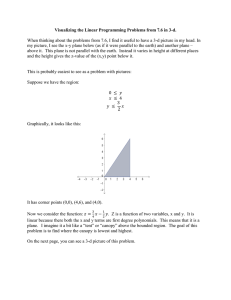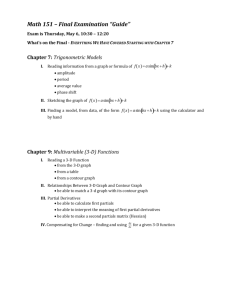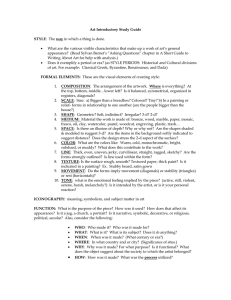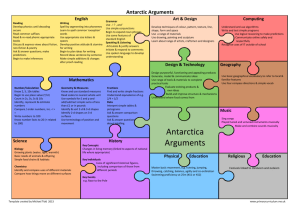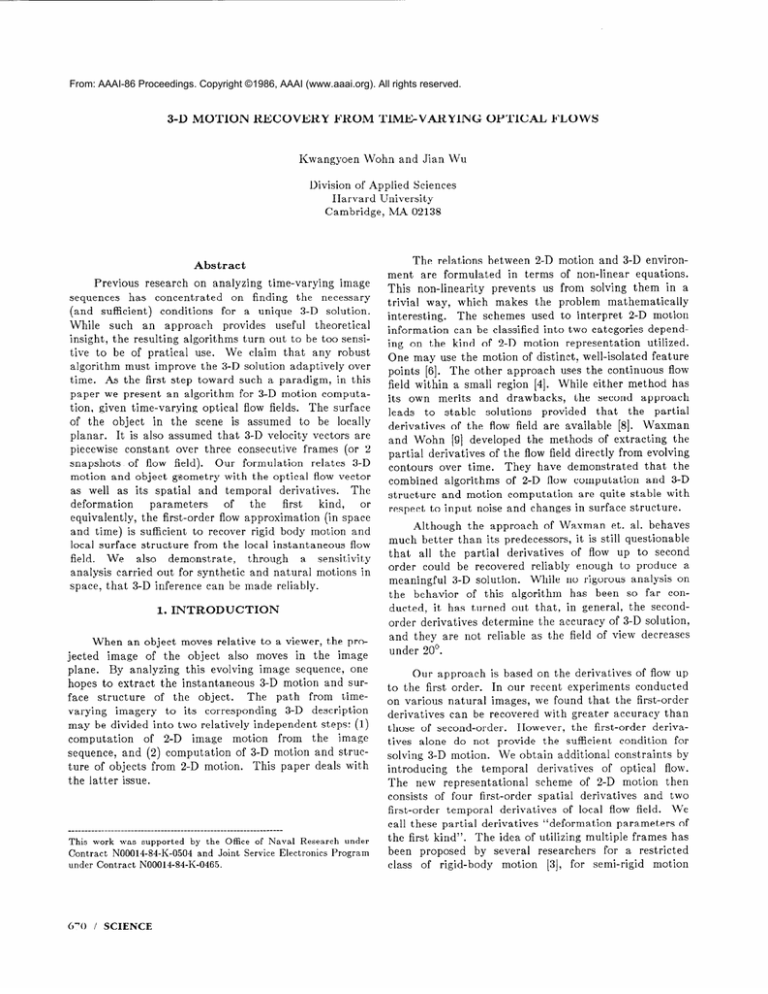
From: AAAI-86 Proceedings. Copyright ©1986, AAAI (www.aaai.org). All rights reserved.
3-D MOTION
RECOVERY
FROM
Kwangyoen
TIMEVARYING
Wohn
and Jian
OPTICAL
FLOWS
Wu
Division of Applied Sciences
Harvard
University
Cambridge,
MA 02138
Abstract
Previous
research
on analyzing
time-varying
image
sequences
has concentrated
on finding
the necessary
(and sufficient)
conditions
for a unique
3-D solution.
While
such
an approach
provides
useful
theoretical
insight, the resulting
algorithms
turn out to be too sensitive to be of pratical
use. We claim that any robust
algorithm
must improve the 3-D solution adaptively
over
time.
As the first step toward such a paradigm,
in this
paper we present
an algorithm
for 3-D motion computation, given time-varying
optical flow fields.
The surface
of the object
in the scene
is assumed
to be locally
planar.
It is also assumed
that 3-D velocity vectors are
piecewise
constant
over three consecutive
frames
(or 2
Our formulation
relates
3-D
snapshots
of flow field).
motion and object geometry
with the optical flow vector
The
as well as its spatial
and temporal
derivatives.
deformation
parameters
of
the
first
kind,
or
equivalently,
the first-order
flow approximation
(in space
and time) is sufficient
to recover rigid body motion and
local surface structure
from the local instantaneous
flow
field.
We
also
demonstrate,
through
a sensitivity
analysis
carried out for synthetic
and natural
motions in
space, that 3-D inference
can be made reliably.
1. INTRODUCTION
When an object moves relative to a viewer, the projected
image of the object
also moves in the image
plane.
By analyzing
this evolving
image sequence,
one
hopes to extract
the instantaneous
3-D motion and surface structure
of the object.
The path
from timevarying
imagery
to its corresponding
3-D description
may be divided into two relatively
independent
steps: (1)
computation
of 2-D image
motion
from
the image
sequence,
and (2) computation
of 3-D motion and structure of objects
from 2-D motion.
This paper deals with
the latter issue.
__________________----------------------------------------------This work was supported
by the Office of Naval Research under
Contract
N00014-84-K-0504
and Joint Service Electronics
Program
under Contract N00014-84-K-0465.
6’0
/ SCIENCE
The relations
between
2-D motion and 3-D environment are formulated
in terms of non-linear
equations.
This non-linearity
prevents
us from solving them in a
trivial
way, which makes the problem
mathematically
interesting.
The schemes
used to interpret
2-D motion
information
can be classified into two categories
depending on the kind of 2-D motion
representation
utilized.
One may use the motion of distinct,
well-isolated
feature
points [6]. The other approach
uses the continuous
flow
field within a small region [4]. While either method has
its own merits
and drawbacks,
the second
approach
leads
to stable
solutions
provided
that
the partial
derivatives
of the flow field are available
[8]. Waxman
and Wohn [9] developed
the methods
of extracting
the
partial derivatives
of the flow field directly from evolving
They have demonstrated
that the
contours
over time.
combined
algorithms
of 2-D flow computation
and 3-D
structure
and motion computation
are quite stable with
respect to input noise and changes in surface structure.
Although
the approach
of Waxman
et. al. behaves
much better than its predecessors,
it is still questionable
that
all the partial
derivatives
of flow up to second
order could be recovered
reliably
enough to produce
a
While no rigorous analysis
on
meaningful
3-D solution.
the behavior
of this algorithm
has been so far conducted,
it has turned
out that, in general,
the secondorder derivatives
determine
the accuracy of 3-D solution,
and they are not reliable
as the field of view decreases
under 20’.
Our approach
is based on the derivatives
of flow up
to the first order.
In our recent experiments
conducted
on various natural
images, we found that the first-order
derivatives
can be recovered
with greater
accuracy
than
those of second-order.
However,
the first-order
derivatives alone do not provide
the sufficient
condition
for
We obtain additional
constraints
by
solving 3-D motion.
introducing
the temporal
derivatives
of optical
flow.
The new representational
scheme
of 2-D motion
then
consists
of four first-order
spatial
derivatives
and two
first-order
temporal
derivatives
of local flow field.
We
call these partial
derivatives
“deformation
parameters
of
The idea of utilizing multiple frames has
the first kind”.
been proposed
by several
researchers
for a restricted
class of rigid-body
motion
[3], for semi-rigid
motion
under orthographic
projection
[7], and for determining
the focus of expansion
(or contraction)
[l].
In Section
2, we begin our discussion
of the 3-D
motion recovery process, adopting
the new flow representation scheme.
The formulation
given here relates this
new local representation,
of an optical
flow to object
motion and structure,
in terms of eight non-linear
algebraic
equations.
This formulation
requires
that
the
object
surface
be approximated
as locally planar
and
that 3-D velocities
do not change over a short period of
time.
Our method
reveals certain families of degenerate
cases for which the temporal
derivatives
of flow do not
provide
sufficient
independent
information.
In certain
cases, the temporal
change of the first-order
derivatives
may be used.
In some other cases, multiple
solutions
may result due to the non-linearity.
The complete
solution tree is also presented.
We conduct
a stability
analysis
of the algorithm
in Section 3. Some results
of
experiments
conducted
on synthetic
data as well as real
time-varying
images are presented.
Concluding
remarks
and our future direction
follow in Section 4.
(2.2)
Substituting
the above into the flow relation
(2.1), we
get expressions
in the form of a second-order
flow field
with respect
to the image coordinates
(z,y).
On the
other
hand,
non-planar
surfaces
generate
flows which
are not simple polynomials
in the image coordinates.
Following
[8], we form the partial
derivatives
of
flow in equations
(2.1) with respect to the image coordinates and evaluate
them at the image origin; we get the
following four independent
relations:
Vx,x =
-
a,v,
dX
I
vi
(2.3a)
=
v;
+
p,
=
vf:
q
+
R,,
(2.3b)
=
v;
p
-
cl,,
(2.3~)
=
v;
+
dvx
=
-
%Y
b
i-b
&I
&J,
vY,x
=
ax
I
I
au,
2. SPATIO-TEMPORAL
IMAGE
vY,Y
DEFORMATION
Adopting
a 3-D coordinate
system (X, Y, Z) as in
[4] (See Figure l), the relative
motion is represented
in
the
translational
velocity
terms
of viewer
motion:
rotational
velocity
and
the
v =(Vx,
v,,
Vz),
62 = (R,, n2,, f12,). The origin of the image coordinate
system (z, y) is located at (X, Y, Z) = (0, 0, 1).
As a point P in space (located
by position
vector
R) moves with a relative
velocity
U = - (V + RX R),
The corresponding
point p moves with a velocity:
=
dY
I
we
where
parameters
have
ZO
(2.111)
2.1. Spatial Coherence
of Optical Flow
Equations
(2.1) constitute
two independent
relations
Various techniques
for recoveramong seven unknowns.
ing the 3-D parameters
differ by the way the additional
We shall consider
only a sinconstraints
are provided.
gle, smooth surface
patch of some object in the field of
view, such that the surface is differentiable
with respect
Let us further
assume that
to the image coordinates.
such surface patch be locally approximated
by a planar
surface in space as:
the
VY
normalized
v$!E
mot ion
(2.4a,b,c)
zo .
ZO
quantities
on the left-hand
side represent
the
motion
(or geometrical
deformation)
in an
neighborhood.
The above process
adds 4
while replacing
the unknown
Z with p and q.
have 6 relations
(equations
(2.1) evaluated
at
and (2.3)) and 8 unknowns.
2.2. Temporal
These
equations
define
an instantaneous
image
flow
field, assigning
a unique 2-D image velocity
v to each
direction
(3, y) in the observer’s
field of view.
(2.3d)
q,
introduced
vi=-, YY v+-,
The
relative
infinitesmal
relations
Now we
the origin
v;
10
Coherence
of Optical Flow
Unlike
[4] and [8] in which
the additional
constraints
are obtained
by introducing
higher-order
derivatives of flow, we observe that the flow field itself changes
smoothly
over time
unless
the following
situation(s)
occur:
1) abrupt
change of 3-D motion in time, and/or
2) abrupt
change of object distance
in time.
For the latter case, it can be easily shown that the temporal change of object distance
is given by:
1
-gy
dZ
-
=-
i b
dt
v;
+ p (If,{
+ sz,)
+ 9 (Vb
- W(2.5)
and the previous
assumption
on surface
planarity
eliminates
this possibility.
This observation
leads us to
investigate
the way flow field changes over time.
Now,
let us assume that 3-D motion parameters
do not change
all
during
an
infinitesimal
time
period.
at
to time, and utilizing
Differentiating
(2.1) with respect
PERCEPTION
AND ROBOTICS
/ 6’1
(2.5):
(2.6a)
6)
Stationary
over time.
(ii)
v; =o:
Motion
is parallel
Dual solution may exist.
flow:
The flow field does not change
Our method fails to recover 3-D motion.
The complete
solution
tree
to the
is presented
image
plane.
in Figure
3.
(2.6b)
the rate of
where S = - Vi -P
vu, -9
vy. S describes
depth change in time, normalized
by Z, the absolute
distance.
The above quantities
represent
the flow changes
in time, at the center of the image coordinates.
Notice
that
we have
obtained
two
independent
relations
without
introducing
any additional
unknown.
There is a class of motion for which equations
(2.6)
become
redundant
and do not provide
any new conIn such a case, we observe
that the temporal
straint.
change of spatial deformation
may also provide independent relations:
\
z -
V;q
= -v;
where
y = v;-
2.3. Recovery
pv;I
-
s + v;q
f-& -
Vf: f12,,
(2.7b)
V;
(2.7~)
y + v;p
f-ly,
St, + v;
clt,
qv;.
672
/ SCIENCE
AND
EXPERI-
Unlike other existing
algorithms
such as (5,8], our
method
solves
for 3-D motion
without
involving
any
searching
or iterative
improvement.
Given the perfect
deformation
parameters
(or flow field), the algorithm
recovers
the exact 3-D solution.
In practice,
however,
there are various
factors
which reduce the accuracy
of
deformation
parameters.
Beside
the sources
of error
common to any early vision processing
such as the error
due to digitization,
camera
distortion,
noise, truncation
error due to discrete
arithmetic,
etc., there are several
other
factors
which
affect the accuracy
of calculated
values
of deformation
parameters.
In principle,
the
deformation
parameters
may be obtained
first by recovering optical
flow and secondly
by taking
the partial
derivatives
of optical flow. But’ since the differentiation
to recover
process
will amplify
noise, we are unlikely
these partial derivatives
reliably.
3.1.
Recovery
of Optical
Flows
In our experiment
conducted
on the natural
timevarying image, contours
are used as a primary source of
information.
The following
factors
concerning
various
stages of the flow computation
must be considered
and
their effects must be analyzed.
of 3-D Motion
summary,
one
can
determine
except the following cases:
ANALYSIS
(2.74
Once the deformation
parameters
are obtained,
we
can proceed
to recover the 3-D motion and structure
of
a surface patch.
The eight equations
to be solved ((2.1),
(2.3) and (2.6)) involve eight unknowns:
Vi, Vg, Vi,
that
Vi and
f-k, fb,
fh
P and 9. We first observe
Vb are coupled with p and q as seen in equations
(2.3).
This suggests
to us a two-step
method:
(1) to solve for
the products
as a whole, and (2) to separate
them into
individual
parameters.
The detailed
derivation
may be
found in [ll].
When VL= 0, 3-D motion is restricted
to
the motion
parallel
to the image plane.
Substituting
equations
(2.3), one can see
G = 0 into the original
that
the coupled
terms
Vfcp, Vkq, V&p, Vkq cannot
be separated.
We now utilize the temporal
change of
the spatial
deformation
parameters:
vZ,zt, vz,yt, vy,,t and
vy,yt, as depicted
in equations
(2.7).
They
provide
sufficient
constraints
for solving for 3-D parameters.
In
uniquely
3.
SENSITIVITY
MENT
3-D
motion
Imperfect contour extraction and false matching:
Since we utilize the contours
to sample
the image
deformation
experienced
by a neighborhood
in the
image, for all points
on a contour
in the fifst image
there must be corresponding
points on the matching
contour in the second image, and vice versa.
Hence contours such as those which corresponds
to extremal
boundary or shadow
boundary
must be excluded.
However,
there
is no reliable
method
for classifying
edges into
meaningful
categories,
based on the local intensity
measurement.
In fact, the analytic
boundaries
of flow field
suggest a way of classifying
edges [2].
The performance
of edge operators
severely
affects
the forthcoming
computation.
In our current implementation,
contours
are obtained
from the zerocrossings
of
V2G*I.
Although
zerocrossings
possess many attractive
features
by itself, they may not correspond
to the actual
meaningful
edges.
Imperfect normal flow estimation:
Having determined the pair of matching
contours,
one can measure
only the norms/ flow around
the contour,
whereas
the
motion along the contour
is invisible.
We make use of
geometrical
displacements
normal to contours
as shown
in Figure 2. Since the points along the contour generally
have some component
of motion tangential
to the contour as well, the measured
normal flow in this way is not
exactly
equal to the true normal
flow. In most cases,
the effect of this tangential
component
on the resulting
full flow is not negligible
and the 3-D solution
becomes
of no use at all. In this regard, we developed
an algorithm which iteratively
improves
the normal
flow estimates [12].
Inaccurate flow model:
Given the normal flows, the
deformation
parameters
(or equivalently
optical
flow)
can be recovered
by the Velocity
Functional
Method
proposed
by [9]. It considers
the second-order
flow
approximation
as the starting
point of flow recovery.
It
then computes
the best-fitting
second-order
flow from
the local measure
of normal flow. Although
the secondorder terms will not be used at the later stage of 3-D
motion computation,
they are included
here in order to
“absorb”
noise, and thereby
to obtain
more accurate
spatial
deformation
parameters.
Currently
temporal
deformation
parameters
are obtained
by subtracting
the
spatial
deformation
parameters
over two consecutive
image frames.
Alternatively,
as a better
approach,
the
velocity
can be approximated
as the truncated
Taylor
series in the spatio-temporal
coordinates
(z, y, t).
In general,
such approximation
is not exact.
It
involves the truncation
error which is characterized
by
many quantities.
However,
as we have mentioned
in
Section
2, the second-order
approximation
is exact for
planar surfaces.
For curved surfaces,
it has been shown
that the exact error formula is determined
mainly by the
surface curvature
and the size of the neighborhood
[lo).
By keeping the neighborhood
size small enough, one can
still rely on the second-order
model.
Non-uniform
3-D motion:
In the mathematical
sense, non-uniformity
of motion is not a problem
since
all we need is the change
of flow in infinitesmal
time
period.
In
practice,
we
have
to
subtract
(or
differentiate)
two
flow
fields,
which
means
three
snapshots
of images are needed at least.
The motion is
assumed
to be constant
during this time interval.
The
effect of 3-D motion
change,
i.e. acceleration,
on the
first-order
image deformation
can be shown to be proportional
to the amount of acceleration.
3.2. Experiment
In the first experiment,
we test the sensitivity
of the
proposed
algorithm
by using synthetically
generated
data.
Typical
sensitivity
is well illustrated
by the following case.
A planar surface
in space is described
by
z = Zu+pX
+ qY with
Z0 = 10 units,
and p and q
corresponding
to slopes of 30’ and 45’, respectively.
The
observer
moves with translational
velocity
V = (5, 4, 3)
units/frame
and rotational
velocity
ha = (20, -10, 30)
degrees/frame.
On the image plane we specify two algebraic curves along which the normal
Aow can then be
computed
exactly (S ee Figure 4a). We then perturb
the
magnitude
and direction
of the normal flow vectors randomly
(from
a uniform
distribution),
‘bounded
by a
specified
percentage
of the exact normal
flow (Figure
4b).
The viewing
angle is fixed at 20’. The Velocity
Functional
Method
is then applied
to the input normal
flows (Figure 4~). We consider
three measures
of sensitivity which
characterize
the relative
error in surface
orientation
es, in translation
eT, and in rotation
eR .
One can see from Table 1 that the sensitivity
of 3-D
structure
and motion predictions
is fairly linear to the
normal
flow. We have found that perturbations
to the
normal
flow of about
20% can be tolerated
down to
fields of view of about 10’.
In the next example,
the normal
flow vectors
are
measured
from the synthetic
images.
The same contours
defined
above
undergo
the following
motion:
translational
velocity
V’ = (0.06, 0.03, -0.04)
and rotational
velocity
!J = 0. The slope of the surface
is measured
roughly as p = 30’ and q = 45’ . Three frames of digital images (of size 256 by 256) were generated
from the
graphical
simulation
program
(Figures
5a).
Normal
flows along the contours
are measured
from the pair of
consecutive
frames (Figure 5b). The iterative
process in
[12] was used to recover the full flows (Figure 5~). The
3-D parameters
computed
from this full flow are: V’ =
(0.059, 0.028, -0.038) units/frame,
ib = (-0.0021,
0.0006,
-0.0007)
degrees/frame,
p = 31.87’ and q = 46.26’ .
As the last example,
Figure 6a shows one of three
consecutive
images obtained
from the natural
environment.
A CCD camera
with known viewing
angle and
focal length was attached
to-a robot arm so that the
camera
can follow
a predetermined
trajectory.
The
images are 385 by 254 in size, with 6 bits of resolution.
The motion
between
the successive
frames
is given as
V’ = (0.6, -0.25, 0.4) and R = 0. The orientation
of the
table was given as p = -10’ and q = 55’. A pyramidbased flow recovery scheme being developed
is applied to
the
input
images.
Figure
6b shows
the
flow field
obtained
from the first two frames,
assuming
that the
entire
image consists
of a single planar
surface.
3-D
parameters
computed
from this flow field are:
V’ =
(0.45, 0.18, 0.57) units/frame,
n = (0.028, -0.037, 0.021)
degrees/frame,
p = -25.11’ and q = 56.29’ .
PERCEPTION
AND ROBOTICS
/ 673
4. CONCLUDING
REMARKS
This work is a part of the hand-eye
coordination
project
at Robotics
Laboratory,
Harvard
University.
In
order to provide
3-D geometrical
information
of scene
from visual data, binocular/time-varying
images will he
used as main visual source.
which
wcovers
3-D
\Ve presented
an algorithm
structure
and motion
from the first-order
deformation
parameters.
In most cases, such cdeformation
parameters can be recovered
quite reliabllr.
1”\*e carried ollt a
sensitivity
analysis
for synthetic
and natllral
motions in
space, to demonstrate
that 3-D information
can also be
Although
many independent
factors
recovered
reliably.
affect
the accuracy
of 3-D solution,
we have found,
through
various
experiments,
that the temporal
deformation
given as II, t and uY t plays t-he major role on
the sensitivity.
hlore work should be done on the fiow
1\7e are currently
investigating
a
recovery
scheme.
integrates
several
approach
which
muti-resolution
different
methods
of flow computation.
The 3-D solution
can also be improved
further
by exploiting
the idea of
3-D motion coherence
on the level of 3-D motion compufiltering scheme
tation.
We are developin, 0 a predicti\re
based on a dynamic
model.
REFERENCES
[l]
[i]
“~~Iasimizing
Rigidity:
The Incremental
S. Ullman,
Recovery
of 3-D Structure
and Rubbery
hlotion”,
zl.1. _Uemo 721, M.I.T., June 1983.
[8]
A. Wasman,
and S. Ullman, “Surface
Structure
and
3-D Motion
From
Image
Flow:
A Kinematic
Intl. Journal of Robotics
Research
4, 72Analysis”,
94. 1985.
[o]
A. M. Wasman
and K. Wohn, “Contour
Evolution,
Neighborhood
Deformation
and Global Image Flow:
Intl. Journal of RobotPlanar
Surfaces
in Motion”,
ics Research
4, 95-108, 1985.
[lo] II;. l\rolln and A. M. Waxman,
“Contour
Evolution,
Neighborhood
Deformation
and Local Image Flow:
Curved
Surfaces
in Motion”,
Computer
Science
Tech. Report
TR-1531,
July, 1985.
[II]
K.
and
January
“Inferring
Local Surface Orientation
D. D. Hoffman,
from hlotion Fields” , .Journal Optical Sot. I~tvl. 72,
888-892, 1982.
[4]
I-I. Longuet-Higgins
and 1~. Prazdny,
“The lntprpretation
of a Moving
Retinal
Image”,
J’YOC. Iloycrl
Sot. Lodon
B 208, 385-397, 19SO.
J. Wu, “Recovery
of 3-D Structure
from l’st-Order
Image Deformation”.
Lab.
Tech.
Report,
Harvard
University,
1986.
J. Wu and R. Brockett,
“A
[la] K. IYohn,
of Optical
Flows
by
based
Recovery
Robotics
Lab. Tech. Report,
Improvement”,
University.
June 1986.
noise
eT
eR
0 %
5%
10%
15%
20%
25%
0.000%
0.000%
0.171%
1.294%
4.324%
10.080%
18.338%
1.493%
4.532%
8.218%
11.115%
12.523%
IL
Prediction
of Visual
and Edge Detection
Ph.D.
Dissertation,
[3j
and
hlotion
Robotics
,4. Bandyopadhvay .
and J. Aloimonos,
“Perception
of Rigid Motion
from Spatio-Temporal
Derivatives
Computer
Science TR-157,
Univ.
of Optical Flow”,
Rochester,
March 198.5.
iiComputer
[‘?I 111. F. Clocksin,
Thresholds
for Surface
Slant
from
Optical
Flow
Fields”,
Univ. Edinburgh,
1080.
12’ohn
Table
.
Relatil-e error in 3-D solution
respect to the noise in normal
ContourIteratil-e
Harvard
with
flex-.
[.5] A. hlitiche,
“On Kineopsis
and Computation
of
Structure
and Motion”,
IEEE Trans. Pattern
;1nal.
Afach. Intell.
6, 109-112, 1986.
[6]
6-4
“T.iniqueness
and EstiR. Y. Tsai and T.S. Huang,
mation of 3-D Motion Parameters
of Rigid Objects
with Curved Surfaces”.
IEEE Trn~s. Patter)1 Anal.
:\fach. Intell.
6, 13-27, 1984.
/ SCIENCE
Figure
1.
3-D coordinate
system and 2-D image coordinates with motion relative to an object.
a)
y-7
Li
0
L!
frame #I
Figure 2.
Estimating normal flow.
The normal flow cannot be obtained exactly
due to the tangential component.
6%
L, -”
V,fO
unique
vncv
d
dual
Figure 3.
frame #3
Figure 5. Recovering optical flow from contours.
a) contours on the image planes as input.
(3 frames&are shown.)
b) measured normal flow along the contours
(from frame #l and #2).
c) optical flow field recovered.
no solution
v I/
v
nzo
A
unique
frame #2
l-l-0
D
unique
Solution tree for 3-D structure
and motion algorithm.
b)
..--.--4
.-- - . _ - -,+.. . CT--. . -ci
.a. . . Ax......
7
Figure 4. Recovering full flow from normal flow.
a) contours on the image plane.
b) normal flow along the contours as
input (no noise added).
c) optical flow field recovered.
Figure 6. Recovering optical flow from natural images.
a) input images. (One frame is shown).
b) flow field recovered (with zerocrossings).
PERCEPTION
AND ROBOTICS
/ 675




